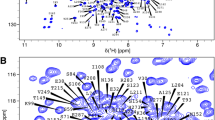Abstract
The aminoglycoside phosphotransferase(3′)-IIIa (APH) is a promiscuous enzyme and renders a large number of structurally diverse aminoglycoside antibiotics useless against infectious bacteria. A remarkable property of this ~31 kDa enzyme is in its unusual dynamic behavior in solution; the apo-form of the enzyme exchanges all of its backbone amide protons within 15 h of exposure to D 2 O while aminoglycoside-bound forms retain ~40% of the amide protons even after >90 h of exposure. Moreover, the number of observable peaks and their dispersion in HSQC spectra varies with each aminoglycoside, rendering the resonance assignments very challenging. Therefore, the binary APH–tobramycin complex, which shows the largest number of well-resolved peaks, was used for the backbone resonance assignments (Cα, C, N, H, and some Cβ) of this protein (BMRB-16337).


Similar content being viewed by others
References
Boehr DD, Thompson PR, Wright GD (2001) Molecular mechanism of aminoglycoside antibiotic kinase APH(3′)-IIIa–Roles of conserved active site residues. J Biol Chem 276:23929–23936
Cox JR, McKay GA, Wright GD, Serpersu EH (1996) Arrangement of substrates at the active site of an aminoglycoside antibiotic 3′-phosphotransferase as determined by NMR. J Am Chem Soc 118:1295–1301
Fong DH, Berghuis AM (2002) Substrate promiscuity of an aminoglycoside antibiotic resistance enzyme via target mimicry. EMBO J 21:2323–2331
Grishaev A, Steren CA, Wu B, Pineda-Lucena A, Arrowsmith C, Llinás M (2005) ABACUS, a direct method for protein NMR structure computation via assembly of fragments. PROTEINS: Struct Funct Bioinform 61:36–43
McKay GA, Wright GD (1995) Kinetic mechanism of aminoglycoside phosphotransferase type Iiia–evidence for a theorell-chance mechanism. J Biol Chem 270:24686–24692
Norris AL, Serpersu EH (2009) NMR detected hydrogen-deuterium exchange reveals differential dynamics of antibiotic- and nucleotide-bound aminoglycoside phosphotransferase 3′-IIIa. J Am Chem Soc 131:8487–8594
Özen C, Serpersu EH (2004) Thermodynamics of aminoglycoside binding to aminoglycoside-3′-phosphotransferase IIIa studied by isothermal titration calorimetry. Biochemistry 43:14667–14675
Özen C, Malek JM, Serpersu EH (2006) Dissection of aminoglycoside-enzyme interactions: a calorimetric and NMR study of neomycin B binding to the aminoglycoside phosphotransferase(3′)-IIIa. J Am Chem Soc 128:15248–15254
Özen C, Norris AL, Land M, Tjioe E, Serpersu EH (2008) Detection of specific solvent rearrangement regions of an enzyme: NMR, ITC studies with aminoglycoside phosphotransferase(3′)-IIIa. Biochemistry 47:40–49
Shen Y, Bax A (2007) Protein backbone chemical shifts predicted from searching a database for torsion angle and sequence homology. J Biomol NMR 38:289–302
Acknowledgments
This research was supported by a Grant from the National Science Foundation (mostly through MCB 01110741 and a small extend through MCB-0842743 to EHS), the Center of Excellence for Structural Biology, and the Hunsicker Research Award through the Department of Biochemistry Cellular and Molecular Biology at the University of Tennessee. This research benefited from activities at the Southeast Collaboratory for High-Field Biomolecular NMR, a research resource at the University of Georgia, funded by the National Institute of General Medical Sciences (NIGMS grant number GM66340) and the Georgia Research Alliance.
Author information
Authors and Affiliations
Corresponding author
Rights and permissions
About this article
Cite this article
Serpersu, E.H., Özen, C., Norris, A.L. et al. Backbone resonance assignments of a promiscuous aminoglycoside antibiotic resistance enzyme; the aminoglycoside phosphotransferase(3′)-IIIa. Biomol NMR Assign 4, 9–12 (2010). https://doi.org/10.1007/s12104-009-9195-z
Received:
Accepted:
Published:
Issue Date:
DOI: https://doi.org/10.1007/s12104-009-9195-z




